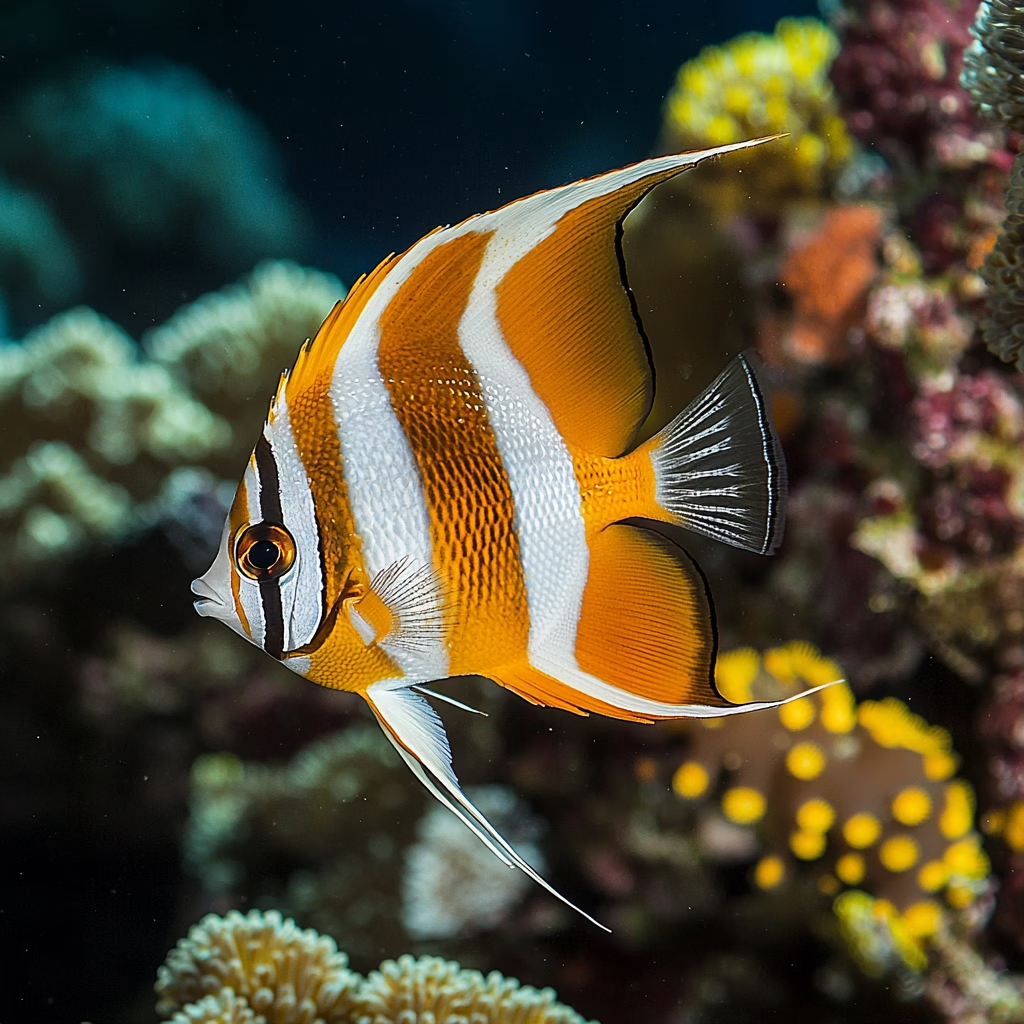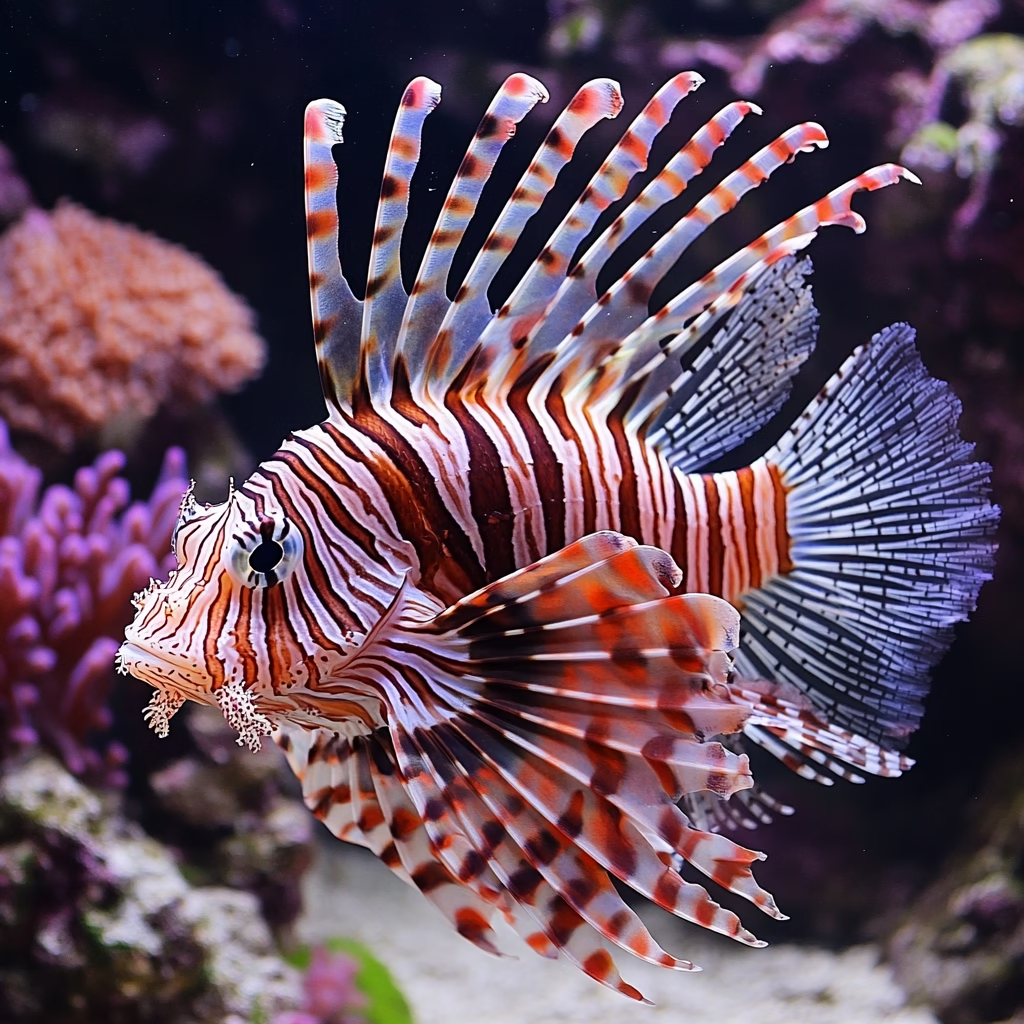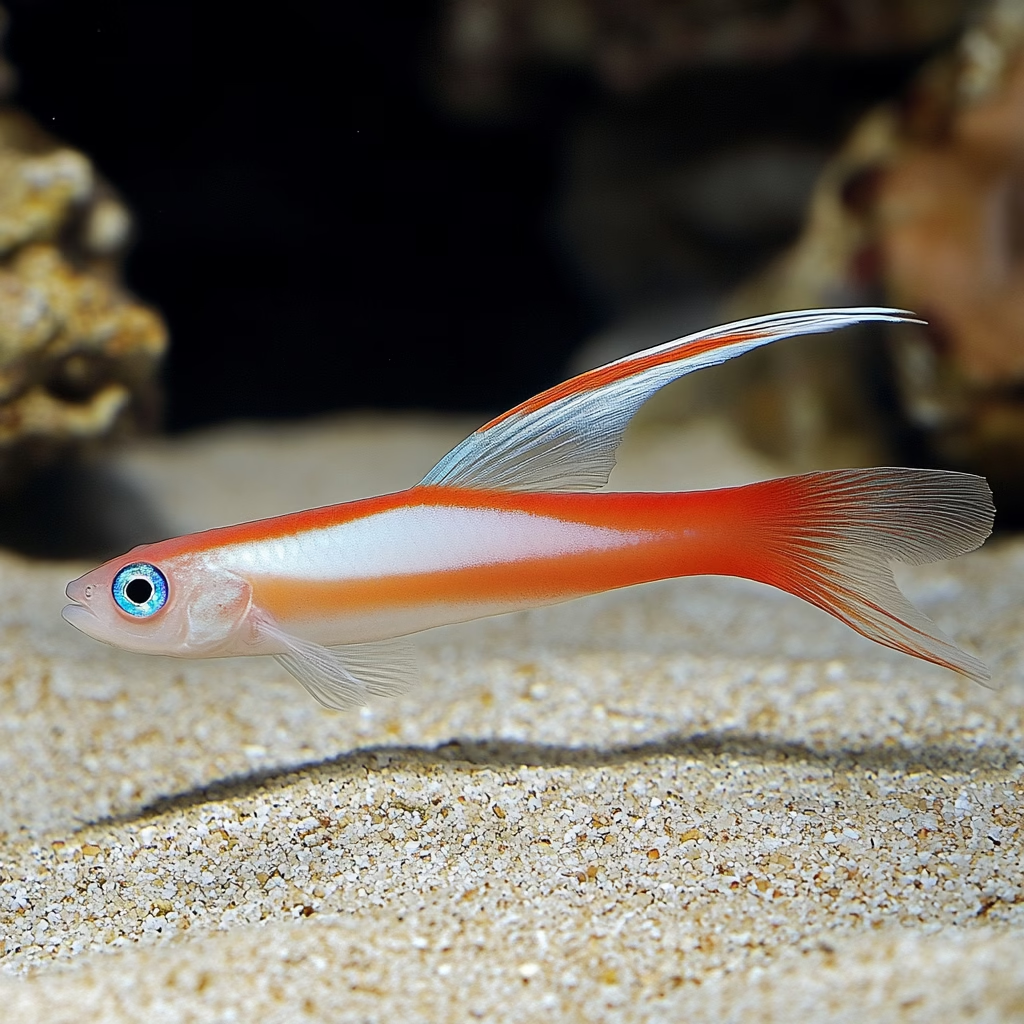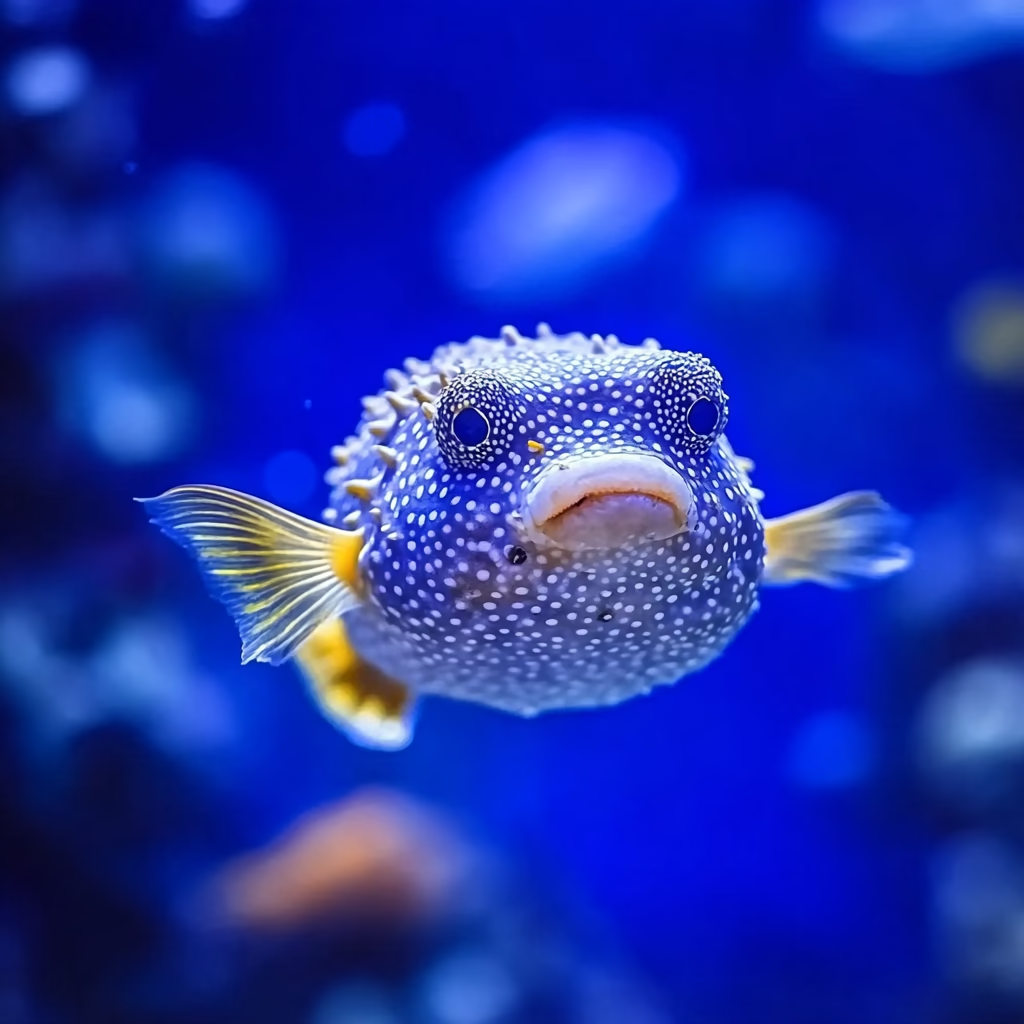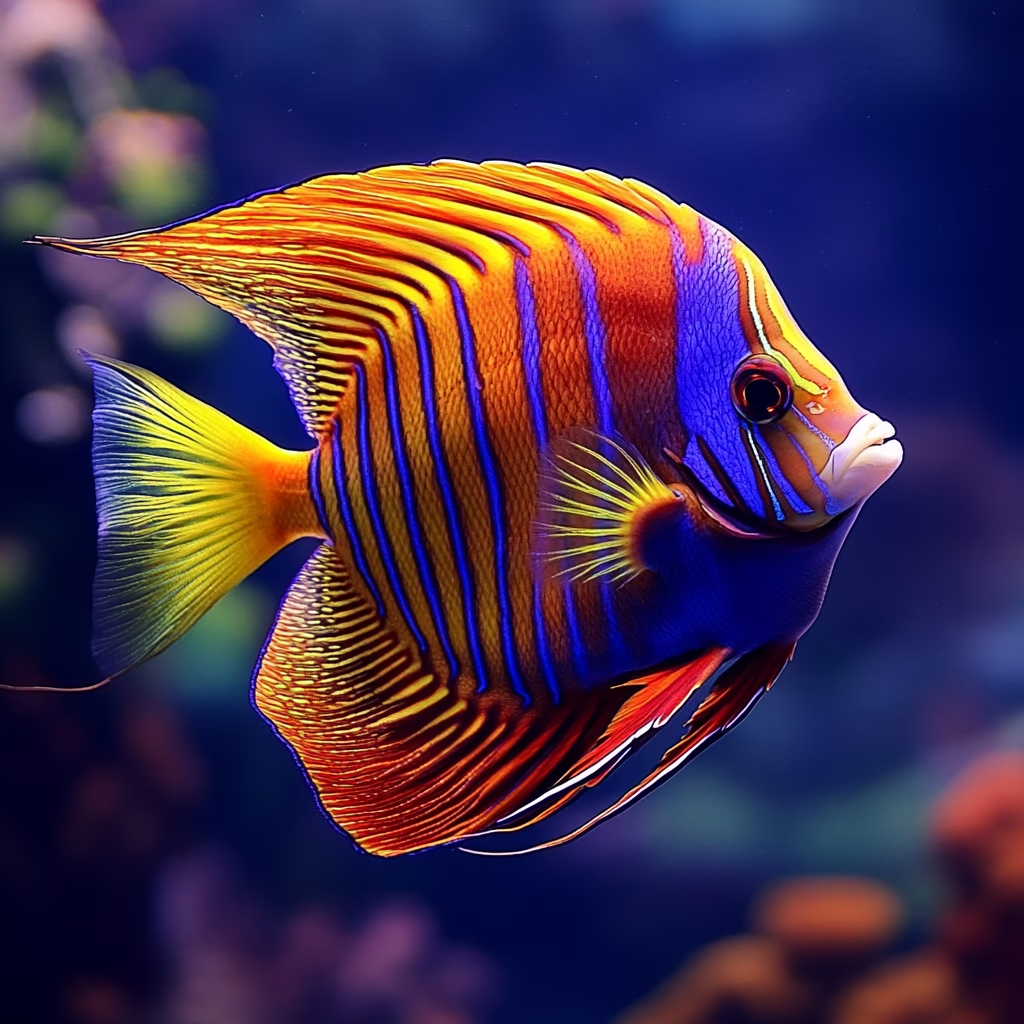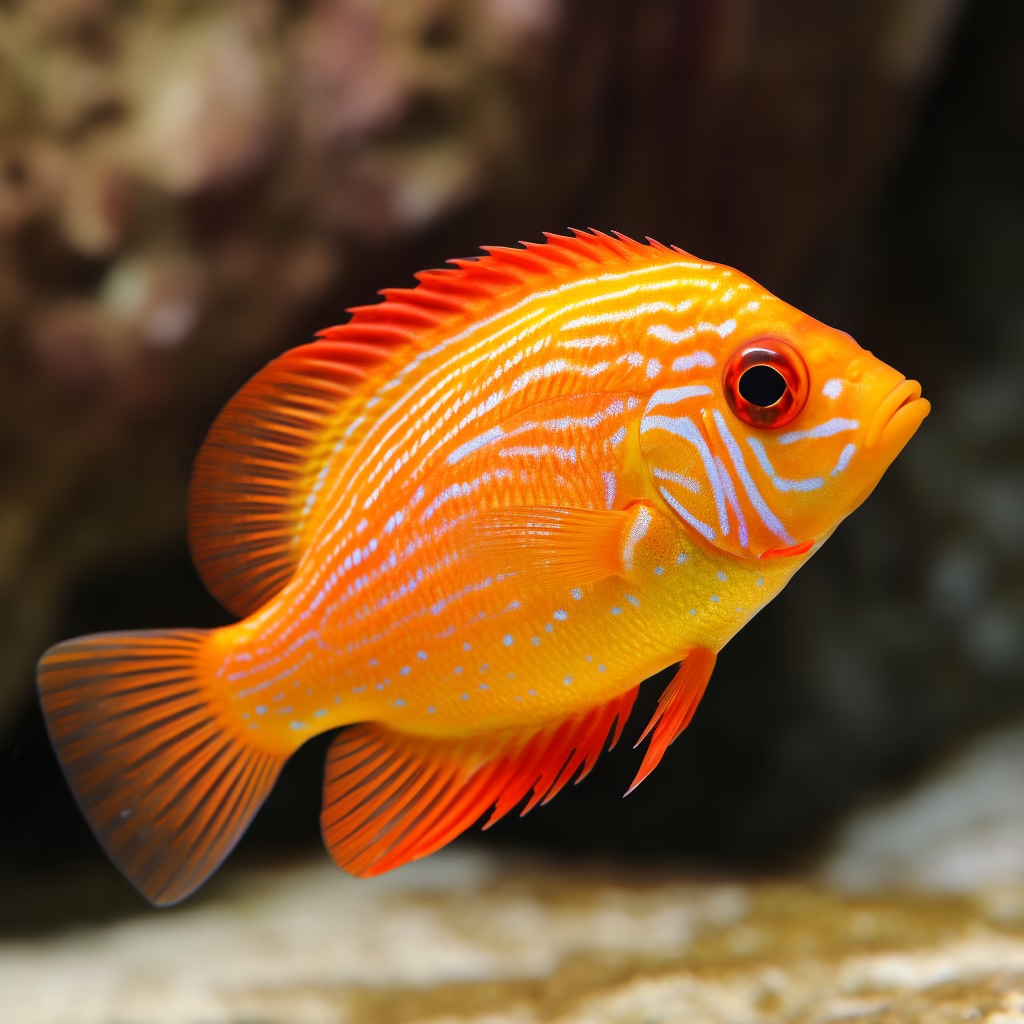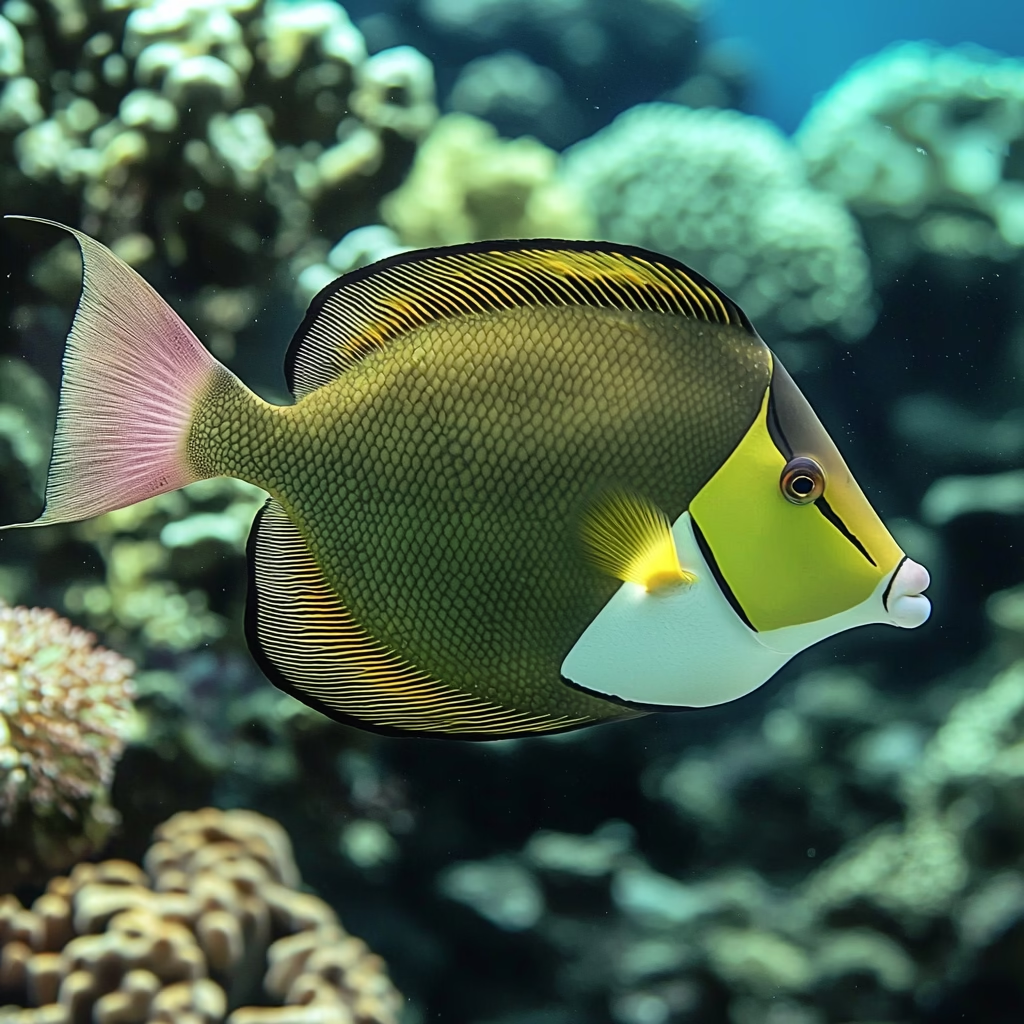Butterflyfish (family Chaetodontidae) are among the most visually striking and immediately recognizable fish found on coral reefs worldwide. With their disc-shaped bodies, distinctive coloration patterns, and graceful movements, these fish have captivated the attention of divers, marine enthusiasts, and aquarists for generations. Often described as the “jewels of the coral reef,” butterflyfish add splashes of vibrant color to tropical marine ecosystems from the Indo-Pacific to the Caribbean.
Physical Characteristics and Identification
Distinctive Body Shape and Features
Butterflyfish possess several characteristic physical features that make them readily identifiable even to casual observers:
- Compressed, Disc-Shaped Body: Their laterally flattened, almost disc-like body form allows them to maneuver efficiently among coral branches and reef structures.
- Continuous Dorsal Fin: Most species feature a single, continuous dorsal fin that extends along much of the body length.
- Small, Protruding Mouth: Their mouths are typically small and often extend outward in a tube-like fashion, perfectly adapted for their specialized feeding habits.
- Eye Concealment: Many species feature a dark vertical band running through the eye (called an “ocular band”), which may help conceal the eye from predators.
- False Eyespots: Some species display conspicuous eyespots (ocelli) near their tail, potentially confusing predators about which end is the head.
- Size Range: Most butterflyfish species measure between 4-8 inches (10-20 cm) in length, though some may reach up to 12 inches (30 cm).
One of the most distinctive features of butterflyfish is their “snout” – an adaptation that varies significantly between species depending on their feeding preferences. Species that feed primarily on coral polyps typically have longer, more pointed snouts that allow them to reach into small crevices and coral structures, while those that feed on larger invertebrates or algae often have shorter, more robust snouts.
Color Patterns and Species Diversity
The extraordinary diversity of color patterns among butterflyfish species reflects their evolution in the visually complex environment of coral reefs:
- Contrasting Bands and Stripes: Many species feature bold vertical, horizontal, or diagonal bands or stripes, often in black and white or yellow contrasted with darker colors.
- Eyespots and Ocelli: Conspicuous circular markings resembling eyes appear at the rear of many species, potentially redirecting predator attacks away from the actual head.
- Species-Specific Patterns: Each species typically has a unique color pattern that serves as a visual signature, facilitating species recognition for mating and territorial purposes.
- Regional Variations: Some widespread species show geographic variations in coloration across their range, reflecting adaptation to local conditions.
The family’s remarkable diversity is exemplified by iconic species such as:
- The Raccoon Butterflyfish (Chaetodon lunula), with its distinctive black “mask” across the eyes
- The Ornate Butterflyfish (Chaetodon ornatissimus), adorned with intricate orange, white, and black patterns
- The Threadfin Butterflyfish (Chaetodon auriga), featuring a characteristic long filament extending from its dorsal fin
- The Four-spot Butterflyfish (Chaetodon quadrimaculatus), displaying prominent black spots against a bright yellow background
This diversity of species and coloration patterns makes the family Chaetodontidae one of the most visually spectacular groups of fish in marine ecosystems.
Distribution and Habitat Preferences
Global Distribution
Butterflyfish are primarily associated with tropical and subtropical coral reef environments, with their distribution encompassing three major oceanic regions:
- Indo-Pacific Region: The greatest diversity of butterflyfish species is found in the coral triangle area encompassing Indonesia, the Philippines, and Papua New Guinea, where up to 50 different species may coexist on a single reef system.
- Red Sea and Western Indian Ocean: This region hosts numerous endemic species that have evolved in relative isolation.
- Tropical Atlantic and Caribbean: Though less diverse than Indo-Pacific regions, the Caribbean and Western Atlantic are home to several distinctive butterflyfish species, including the Foureye Butterflyfish (Chaetodon capistratus) and the Reef Butterflyfish (Chaetodon sedentarius).
The pattern of butterflyfish distribution reflects the historical development of coral reef ecosystems, with species richness generally decreasing with distance from the Indo-Pacific biodiversity hotspot. This pattern, known as the Indo-Pacific biodiversity gradient, is particularly pronounced in this family.
Preferred Reef Zones and Microhabitats
Butterflyfish exhibit distinct preferences for particular reef zones and microhabitats, with different species occupying specific niches within the reef ecosystem:
- Reef Flats and Shallow Lagoons: Species like the Threadfin Butterflyfish (Chaetodon auriga) commonly inhabit these high-light, wave-impacted environments.
- Reef Crests and Upper Reef Slopes: Many butterflyfish species thrive in these zones of high coral diversity and water movement.
- Deep Reef Slopes: Certain specialized species, such as members of the genus Prognathodes, have adapted to deeper, more dimly lit reef environments.
- Rubble Zones and Sandy Areas: Some species forage primarily in areas adjacent to coral structures rather than on the reef itself.
Microhabitat specialization is often linked to feeding preferences, with coral-feeding species typically found in areas with abundant live coral cover, while species that feed on benthic invertebrates may range more widely across different substrate types. This specialization contributes to the ability of multiple butterflyfish species to coexist within a single reef system, each exploiting slightly different resources.
Feeding Ecology and Diet Specialization
Diverse Feeding Strategies
Butterflyfish exhibit fascinating feeding specializations that vary significantly between species:
- Obligate Corallivores: Species like the Ornate Butterflyfish (Chaetodon ornatissimus) feed almost exclusively on coral polyps, often showing strong preferences for specific coral species.
- Facultative Corallivores: These species consume coral as part of a broader diet that may include other invertebrates and algae, providing greater dietary flexibility.
- Benthic Invertebrate Feeders: Many butterflyfish species primarily consume small invertebrates living on or within the reef substrate, such as worms, small crustaceans, and mollusks.
- Omnivores: Some species, particularly in the genus Heniochus, have more generalized diets that include both animal and plant material.
- Planktivores: A few species, notably those in the genus Hemitaurichthys, feed primarily by picking zooplankton from the water column above the reef.
This diversity of feeding strategies has led to corresponding adaptations in mouth structure, with species specialized for different food types having distinctly shaped jaws, teeth, and snouts. The bristle-like teeth that give the family its scientific name (Chaetodontidae, from the Greek “chaite” meaning hair and “odont” meaning tooth) are particularly well-adapted for picking small items from complex surfaces.
Impact on Reef Ecosystems
The feeding habits of butterflyfish have significant implications for reef ecology:
- Coral Health Regulation: By selectively feeding on coral polyps, corallivorous butterflyfish may influence coral community composition and potentially control coral growth rates.
- Algae Control: Species that consume algae help maintain the delicate balance between corals and algae on healthy reefs.
- Energy Transfer: As midlevel consumers, butterflyfish transfer energy from primary producers and small invertebrates to larger predatory fish.
- Bioindicator Function: Due to their dietary specialization, many butterflyfish species are highly sensitive to changes in coral health, making their presence or absence a useful indicator of reef condition.
Research has shown that some coral species have developed defensive mechanisms against butterflyfish predation, including increased nematocyst (stinging cell) density and altered polyp behavior, highlighting the evolutionary relationships between these fish and their coral prey.
Social Behavior and Reproduction
Pair Bonding and Social Structure
One of the most fascinating aspects of butterflyfish behavior is their tendency toward monogamy and long-term pair bonding:
- Monogamous Pairs: Many species form long-term, possibly lifelong, pair bonds that persist throughout the year, not just during breeding seasons.
- Territorial Defense: Mated pairs typically defend feeding territories against conspecifics and sometimes other butterflyfish species with similar diets.
- Coordinated Swimming: Paired butterflyfish often swim in close proximity to each other, maintaining visual contact and coordinating their movements.
- Social Hierarchies: In areas of high population density, dominance hierarchies may develop between different pairs or individuals.
The strength of pair bonding varies between species, with obligate corallivores generally showing stronger and more persistent pairing behavior than more generalist feeders. This may reflect the greater importance of defending high-quality feeding territories when dietary options are limited.
Some species, particularly planktivorous butterflyfish, may form larger schools rather than pairs, especially when feeding in the water column above the reef. This alternative social strategy appears to be linked to their different feeding ecology and reduced need for territory defense.
Reproductive Biology and Early Life History
Butterflyfish reproduction follows patterns common to many reef fish, with some distinctive characteristics:
- Spawning Behavior: Most species are broadcast spawners, releasing gametes into the water column at dusk, often during specific lunar phases.
- Pelagic Larval Phase: Fertilized eggs develop into planktonic larvae that drift with ocean currents for 40-70 days before settlement.
- Distinctive Larval Form: Butterflyfish larvae pass through a “tholichthys” stage with distinctive bony plates covering the head, offering protection during the vulnerable pelagic phase.
- Settlement Site Selection: Juvenile butterflyfish often settle in habitat distinct from adult territories, typically in more sheltered areas.
- Ontogenetic Color Changes: Many species undergo dramatic color and pattern changes as they develop from juveniles to adults, with juveniles often having entirely different patterns from adults of the same species.
The extended pelagic larval duration of butterflyfish contributes to their wide distribution across oceanic barriers and helps explain the pantropical distribution of the family. However, this extended pelagic phase also means that local populations depend on successful recruitment of larvae that may have originated from distant reefs, creating complex metapopulation dynamics.
Conservation Status and Threats
Vulnerability to Coral Reef Decline
Butterflyfish face numerous threats linked to the global decline of coral reef ecosystems:
- Coral Bleaching: Climate change-induced coral bleaching events have devastating impacts on obligate corallivores that depend on healthy coral for food.
- Ocean Acidification: Decreasing ocean pH threatens the structural integrity of coral reefs and may affect the invertebrate prey base for many butterflyfish species.
- Habitat Destruction: Physical damage to reefs from destructive fishing practices, coastal development, and anchor damage reduces suitable habitat.
- Water Quality Degradation: Pollution, sedimentation, and agricultural runoff negatively impact coral health and, consequently, butterflyfish populations.
- Overfishing for Aquarium Trade: While not typically targeted for food, many butterflyfish species are collected for the marine aquarium trade, sometimes at unsustainable levels.
Studies following major bleaching events have documented significant declines in obligate coral-feeding butterflyfish species, with some local extinctions in severely affected areas. More generalist species typically show greater resilience, highlighting the relationship between dietary specialization and vulnerability to environmental change.
Conservation Efforts and Management
Several approaches are being implemented to protect butterflyfish populations:
- Marine Protected Areas (MPAs): Well-enforced no-take zones allow butterflyfish populations to thrive and potentially seed surrounding areas.
- Sustainable Collection Practices: Certification programs for the marine aquarium trade aim to ensure that butterflyfish are collected using non-destructive methods and at sustainable rates.
- Coral Reef Restoration: Projects to actively restore degraded coral reefs can help recover habitat for butterflyfish and other reef-dependent species.
- Climate Action: Broader efforts to mitigate climate change are critical for the long-term survival of coral reefs and their associated butterflyfish populations.
- Research and Monitoring: Ongoing studies of butterflyfish population dynamics provide valuable data for conservation planning and assessment of reef health.
As highly visible and charismatic species, butterflyfish often serve as flagship species in coral reef conservation initiatives, helping to raise public awareness about the importance of protecting these vulnerable ecosystems.
Butterflyfish in Aquariums
Challenges and Considerations in Captivity
Keeping butterflyfish in home aquariums presents unique challenges due to their specialized nature:
- Dietary Requirements: Obligate coral-feeding species rarely adapt to captive diets and typically fare poorly in aquariums, while omnivorous species generally adapt more successfully.
- Space Needs: Despite their relatively small size, most butterflyfish are active swimmers that require spacious aquariums, typically at least 75-100 gallons for a single pair.
- Water Quality Sensitivity: As reef dwellers, butterflyfish require excellent water quality with stable parameters.
- Territorial Behavior: Many species can be aggressive toward similar-looking fish, necessitating careful planning of tank communities.
- Specialized Care: Even adaptable species often require targeted feeding with marine-based foods rich in sponge and coral material.
Successful long-term maintenance of butterflyfish typically requires experienced aquarists willing to provide specialized care. Certain species, particularly those in the genera Heniochus and Chelmon, are generally considered more suitable for captivity than obligate coral-feeders.
Species Suitable for Aquarium Keeping
While obligate coral-feeders should generally be avoided, several butterflyfish species can adapt well to aquarium life:
- Raccoon Butterflyfish (Chaetodon lunula): One of the hardier Chaetodon species, with an omnivorous diet that adapts relatively well to captive foods.
- Klein’s Butterflyfish (Chaetodon kleinii): Known for its adaptability and relatively peaceful nature.
- Threadfin Butterflyfish (Chaetodon auriga): Moderately adaptable to captivity if provided with proper care and feeding.
- Longsnout Butterflyfish (Chelmon rostratus): Popular for its distinctive appearance and ability to adapt to prepared foods.
- Bannerfish/Pennant Coralfish (Heniochus species): Generally considered among the most adaptable butterflyfish for aquariums.
Responsible aquarists should research the specific needs of individual species and consider the source of the fish, preferring captive-bred specimens when available, though most butterflyfish in the trade are still wild-collected.
Scientific Research and Discoveries
Ecological Studies and Insights
Butterflyfish have been the subject of numerous scientific studies that have yielded important ecological insights:
- Resource Partitioning: Research on how multiple butterflyfish species coexist on the same reef has provided valuable information about niche specialization and resource partitioning in coral reef communities.
- Coral Bleaching Responses: Studies of how different butterflyfish species respond to coral bleaching events help scientists understand the cascading effects of climate change on reef ecosystems.
- Feeding Selectivity: Detailed observations of butterflyfish feeding preferences have revealed complex patterns of selectivity based on coral species, polyp size, and nutritional content.
- Pair Bonding Mechanisms: Research into the neurobiological and behavioral aspects of pair bonding in butterflyfish provides insights into the evolution of monogamy in fish.
- Larval Dispersal: Genetic studies of butterflyfish populations help map larval dispersal patterns and connectivity between reef systems, informing marine protected area design.
These studies contribute not only to our understanding of butterflyfish biology but also to broader ecological theories about species coexistence, specialization, and adaptation to environmental change.
Evolutionary History and Adaptations
The evolutionary history of butterflyfish reveals fascinating patterns of adaptation and diversification:
- Rapid Radiation: Molecular studies suggest that many butterflyfish genera underwent rapid evolutionary radiation, producing numerous species over relatively short evolutionary timeframes.
- Feeding Adaptation: The diverse mouth morphologies seen across the family represent adaptive responses to different feeding niches, demonstrating how natural selection shapes physical traits.
- Color Pattern Evolution: Research indicates that butterflyfish coloration serves multiple functions, from species recognition to disruptive camouflage, with patterns evolving in response to specific ecological pressures.
- Co-evolution with Corals: There is evidence of co-evolutionary relationships between certain butterflyfish species and their preferred coral prey, with each influencing the evolutionary trajectory of the other.
Ongoing research using genomic approaches is providing new insights into the genetic basis of these adaptations and the evolutionary relationships between butterflyfish species and genera.
Cultural and Economic Significance
In Art, Literature, and Popular Culture
Butterflyfish have captured human imagination and appeared in various cultural contexts:
- Traditional Art: They feature in the traditional art of many Pacific Island cultures, appearing in carvings, textiles, and paintings.
- Modern Marine Art: Their distinctive shapes and colors make them popular subjects for contemporary marine artists and photographers.
- Literature and Children’s Books: Their vibrant appearance and interesting behaviors make them common characters in children’s books about marine life.
- Documentary Films: As photogenic reef dwellers, butterflyfish frequently appear in nature documentaries about coral reef ecosystems.
- Symbolism: In some contexts, butterflyfish symbolize beauty, grace, and the delicate balance of reef ecosystems.
Their aesthetic appeal has helped make butterflyfish ambassadors for coral reef conservation, with their distinctive appearance instantly recognizable to many people who have never visited a reef.
Tourism and Economic Value
Butterflyfish contribute significantly to the economic value of coral reefs:
- Dive Tourism: As colorful, diurnal fish that are easily observed, butterflyfish enhance the experience of recreational divers and snorkelers, contributing to the multi-billion-dollar reef tourism industry.
- Aquarium Trade: The collection, transportation, and sale of butterflyfish for marine aquariums provides livelihoods for people in many coastal communities.
- Conservation Value: As indicator species, butterflyfish play a role in monitoring programs that help protect the broader economic value of healthy reef ecosystems.
- Educational Value: Public aquariums worldwide display butterflyfish to educate visitors about coral reef ecosystems and conservation issues.
When managed sustainably, these economic benefits can create incentives for reef protection and provide alternative livelihoods for communities that might otherwise engage in more destructive practices.
Conclusion: Butterflyfish as Ambassadors of Reef Health
Butterflyfish stand out as perfect ambassadors for coral reef ecosystems – their beauty captures attention, their specialized nature highlights the complexity of reef environments, and their vulnerability to reef degradation emphasizes the urgent need for conservation action. Few other fish families so perfectly embody the delicate balance and interdependence that characterize healthy coral reef systems.
As climate change and other anthropogenic stressors continue to threaten reefs worldwide, the fate of butterflyfish serves as a visible indicator of ecosystem health. Their decline in affected areas provides tangible evidence of the consequences of reef degradation, while their persistence or recovery in protected areas offers hope for successful conservation outcomes.
Beyond their ecological significance, butterflyfish remind us of the aesthetic value of biodiversity – the extraordinary colors, patterns, and behaviors that have evolved through millions of years of natural selection. These “jewels of the reef” represent not only fascinating subjects for scientific study but also natural treasures whose preservation enriches human experience and maintains the intricate web of life that sustains marine ecosystems.
As we work to protect coral reefs for future generations, butterflyfish will continue to serve as both warning signals when ecosystems are in trouble and symbols of success when conservation efforts bear fruit. Their future remains inextricably linked with that of the coral reefs they call home, making their conservation a priority for all who value these extraordinary marine ecosystems.

